Recommendation points
- The main elements of the classics framed by decorative stone
- Fireplace decoration
- Features of the choice of texture and color of decorative stone for a classic interior
In this article, we will offer options for using decorative stone in a classic interior. Let’s talk about how you can fit this modern finishing material into a historical design that has “survived” centuries and epochs, choose the optimal texture and palette of artificial stone.
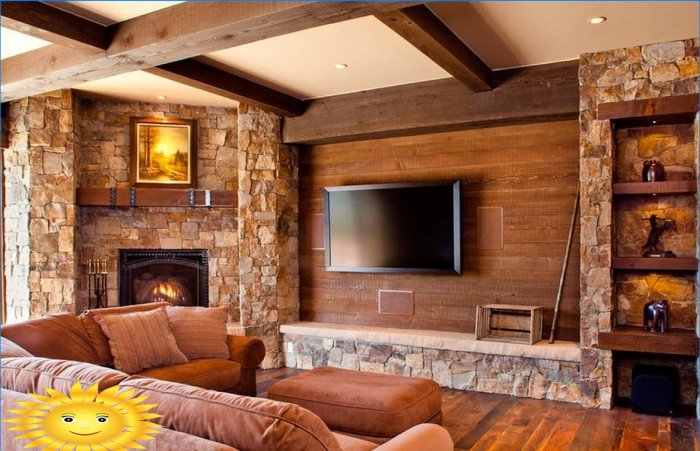
We have already written about the distinctive features of the classic style in the interior in one of the previous articles. But how can you achieve such an easily recognizable effect and design a classic, rather restrained interior with its clean lines and traditional decor??
Note that artificial stone is ideal for a classic interior, allowing you to emphasize adherence to tradition and highlight the main elements inherent in this design direction. We will dwell on the details and features of such a finish in this article..
 Austere, classic interior with clean, straight lines and understated finishes. The decorative stone perfectly emphasized these features of the classic design.
Austere, classic interior with clean, straight lines and understated finishes. The decorative stone perfectly emphasized these features of the classic design.
The main elements of the classics framed by decorative stone
What associations does the combination “classic interior” immediately evoke? Slender columns, high arches, graceful lines of furniture, pastel colors. A decorative stone will fit perfectly into such an environment. However, as is the case with any rich, noticeable design elements, it should be applied carefully – otherwise, you can easily overdo it and make the room look more like a gloomy medieval castle, and not like a modern cozy home..
So, let’s try to figure out which elements of the classic interior the facing stone will emphasize in the best possible way:
- Arches and doorways. This is a versatile way to use artificial stone, which will emphasize, for example, the beauty of a tall arch that connects two rooms. In addition, such a frame will allow you to turn an ordinary doorway into an original decorative element. Another advantage of this method is that the facing stone is highly resistant to external influences and will avoid such an unpleasant phenomenon as wallpaper that is frayed or peeled off at the fold of the arch..
- Columns. This almost indispensable element of a classic living room and in itself looks very noticeable. And the beauty of the decorative stone will make it even more expressive. By the way, a column in a city apartment usually has an exclusively decorative function and can just protrude slightly from the wall, “painted” by means of stone cladding. Such a decorative element is called a pilaster and is traditionally faced with a material that imitates marble or other stone surface..
- Decorative fountain bowl, indoor waterfall, artificial reservoir. Such furnishing elements are becoming more and more popular and need appropriate framing. Imagine a traditional round, stone-faced fountain bowl with an antique statue in the center – which can better emphasize the classic focus of the interior.!
- Spans of stairs. The combination of wrought iron railings, stone steps and stone-faced walls looks in the best traditions of classic mansions. A wooden staircase against a background of stone walls will also look especially respectable..
- Partial or complete wall cladding. Often in a classic interior there are separate strips of artificial stone, dividing the room into functional zones. Another option, inherent only in this historical style, is stone panels depicting heroes of Greek myths or just a beautiful landscape..
- A combination of decorative stone and stucco. Corner ceiling plinth, an essential attribute of the classic style, can be made not only from traditional, but too heavy plaster, but also from polyurethane or polystyrene. In any case, it is against the background of stone decoration that such a ceiling frame looks natural and especially expressive. The same effect is obtained by the combination of a pilaster or column capital and decorative stone. In addition, individual parts of the wall, faced with artificial stone, can be additionally decorated with stucco moldings to emphasize the classics of the interior. Imagine such a “stone picture” framed by traditionally white moldings – indeed, a classic.
Of course, not all of the above methods of using decorative stone are inherent exclusively in the classical style. For example, a doorway in such a frame is more than appropriate in a modern interior. But it is precisely the stone arches and columns in combination with stucco molding that make the classics easily recognizable and unique..
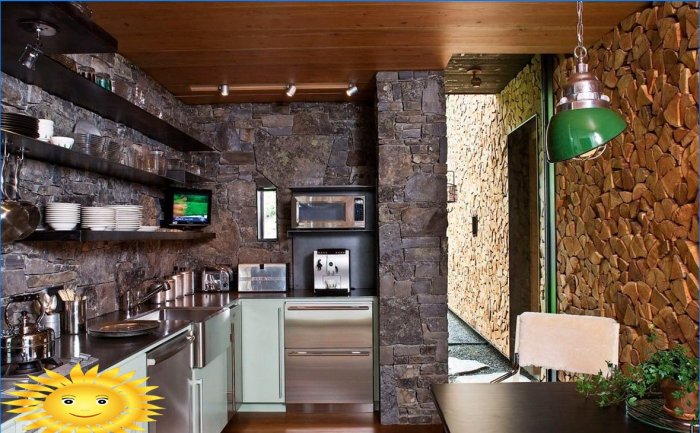 The decorative stone cladding of the doorway in this light, classic kitchen is continued on the backsplash and the wall where the refrigerator is installed. In addition, it was the artificial stone that became the design element that united the work and dining areas.
The decorative stone cladding of the doorway in this light, classic kitchen is continued on the backsplash and the wall where the refrigerator is installed. In addition, it was the artificial stone that became the design element that united the work and dining areas.
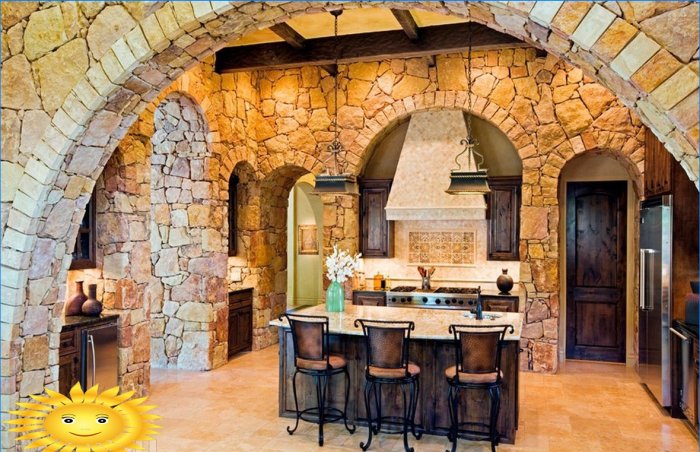 A classic living room in which the walls are completely tiled with artificial stone
A classic living room in which the walls are completely tiled with artificial stone
Fireplace decoration
A special element of the classic interior is the fireplace. Even if it is installed in an ordinary city apartment and its hearth is electric, or even completely replaced by candles, the presence of a fireplace turns an ordinary room into a ceremonial hall and a center of attraction for all family members.
In the classic style, you will not find fireplaces made of metal or tempered glass. Only brick and stone, against which the fire in the hearth becomes a real symbol of the inviolability of family traditions. The easiest way to give a fireplace an aristocratic look is to use a finishing stone.
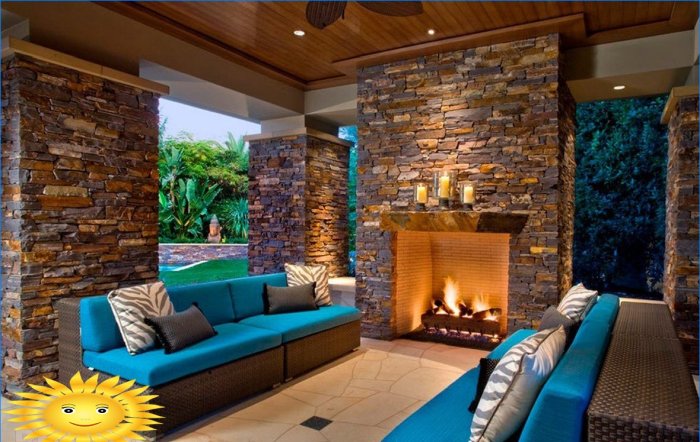
This material is non-flammable and perfectly tolerates temperature changes, making it ideal for decorating the hearth. There are several options for finishing a fireplace with decorative stone:
- Facing the firebox itself in combination with stucco elements and a wooden portal.
- Cladding only the shelves above and below the hearth will emphasize the importance of these elements. In this case, the upper mantelpiece with traditional clocks, candlesticks and flower vases will look especially beautiful..
- Cladding the entire wall into which the hearth is built.
- Facing the chimney protruding from the wall.
- The cladding of the side walls of the fireplace, passing into the wall around. In this case, you can achieve the effect of a hearth built directly into the rock..
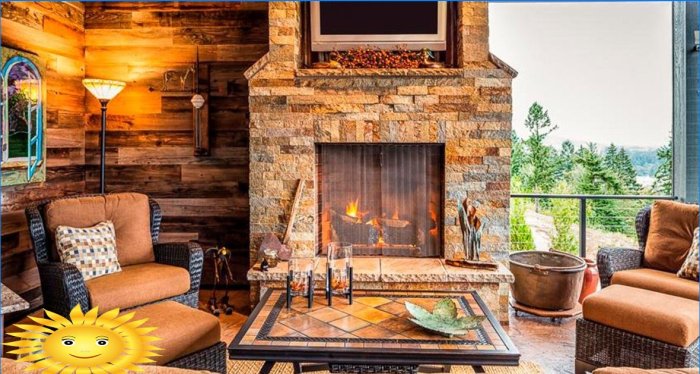 In this case, the fireplace, completely clad in decorative stone, is set against the background of a wooden wall. This is the right approach to not overdo it and to emphasize the importance of the hearth in the interior. And, mind you, a stone of a different texture was chosen to decorate the hearth, and the mantelpiece was created from a stone slab
In this case, the fireplace, completely clad in decorative stone, is set against the background of a wooden wall. This is the right approach to not overdo it and to emphasize the importance of the hearth in the interior. And, mind you, a stone of a different texture was chosen to decorate the hearth, and the mantelpiece was created from a stone slab
Features of the choice of texture and color of decorative stone for a classic interior
There are, of course, many types of artificial stone that so successfully imitates its natural counterpart. However, not all options are suitable for the classic interior..
So, the classics prefers pastel colors, neutral shades and does not accept variegation and a combination of several bright colors in one room. Accordingly, the decorative stone should be chosen exactly in calm shades, for example, gray, beige, pale brown..

If everything is quite simple and clear with the color scheme of decorative stone for a classic interior, then the variety of textures and types of this material can seriously complicate the choice. In general, a deliberately rough, bulky and too large rubble stone does not fit the classics at all. This option is more likely for country or ethnic design. Do not use pebbles, which are more suitable for Mediterranean and nautical styles..
The most suitable types of artificial stone for a classic interior and at the same time popular today are:
- Decorative brick. This type of decorative stone is distinguished by an enviable variety, but for the classical style, for example, brickwork with a noble patina, pale brown, with a grout to match the stone itself, is ideal. This type of artificial stone is great for cladding a fireplace..
- Artificial type-setting slate. The leader in popularity among homeowners today. Its advantage is that the slate forms a continuous stone cover, without seams, its individual parts are very small and will allow you to turn, for example, an arch or a column into a real Alpine rock.
- Sandstone. This decorative stone is of various sizes and is actually a stone mosaic. The use of pieces of different sizes allows you to create real masterpieces, stone paintings and panels. The color scheme is great for classic interior design.
- Limestone. The natural beauty of this stone is in great demand in the creation of original interiors. But for the classics, it is worth choosing a stone with the most graceful and elegant external parameters, since an exact imitation of wild limestone may look too rough..
- Marble and granite. That’s where the “Classic” with a capital letter is! These types of stones have been used in decoration for many years, and artificial imitations of these expensive materials have made them more affordable and even more popular..
Absolutely smooth textures with high reliefs and bas-reliefs are also ideal for the classic direction of interior design. The difference between these options lies in the fact that the high-relief image protrudes from the stone by more than half, while the bas-relief image is usually only one third, up to a maximum of half of the sculpture. That is, the high relief is a more convex image, an almost isolated sculpture that seems to only touch the background..
In any case, when choosing a bas-relief or high-relief for your classic interior, you should give preference to images with subject sculptures showing scenes from Greek myths, just beautiful landscapes, but not urban, but pastoral. Panels (stone images not protruding above the background) are also widely used in the classical style. These stone paintings will help diversify the interior and turn ordinary masonry into a masterpiece of art..
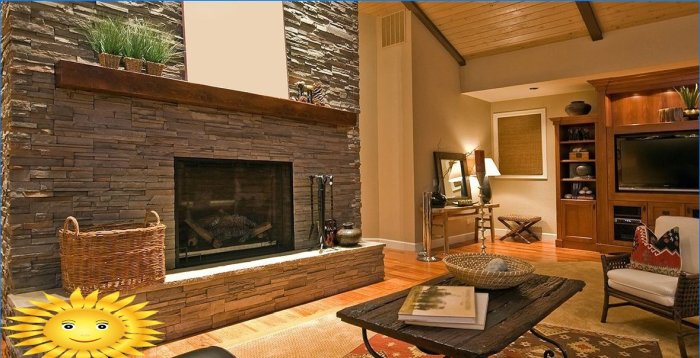 The decision to completely veneer the walls with decorative stone in this case fully justified itself. Firstly, large arched windows did not allow such decoration to turn the room into a gloomy castle. Secondly, the stone itself was chosen very well – it is light gray in color and expressive texture
The decision to completely veneer the walls with decorative stone in this case fully justified itself. Firstly, large arched windows did not allow such decoration to turn the room into a gloomy castle. Secondly, the stone itself was chosen very well – it is light gray in color and expressive texture
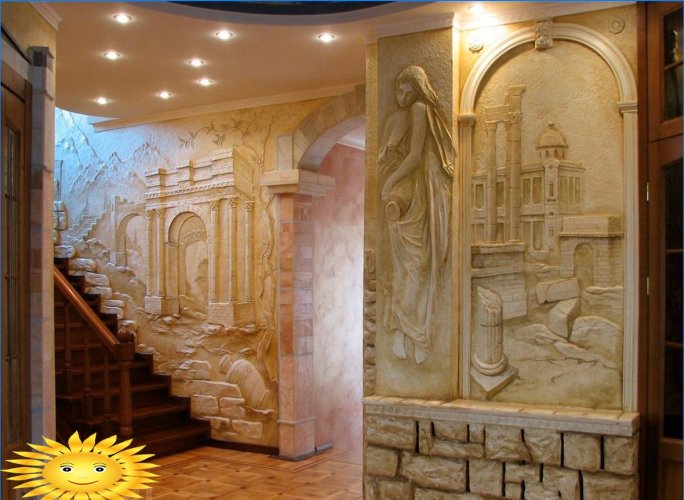 A clear example of the use of a bas-relief in the interior. Such large-scale paintings, of course, will not be appropriate in every room; for residential buildings it is better to select small panels
A clear example of the use of a bas-relief in the interior. Such large-scale paintings, of course, will not be appropriate in every room; for residential buildings it is better to select small panels
The classical style originates from the temples and structures of Ancient Greece, so it is not surprising that stone is a traditional material for decorating such interiors. The appearance of an artificial stone, lighter, characterized by a simple process of installation and maintenance, and most importantly – a more affordable price, made this way to emphasize the classic orientation of interior design much more accessible and popular.

Can decorative stone be a suitable addition to a classic interior design? I’m curious to know if using natural or imitation stone in a classic interior can add charm and elegance, or if it might clash with the traditional elements. Would love to hear your thoughts and experiences on this!